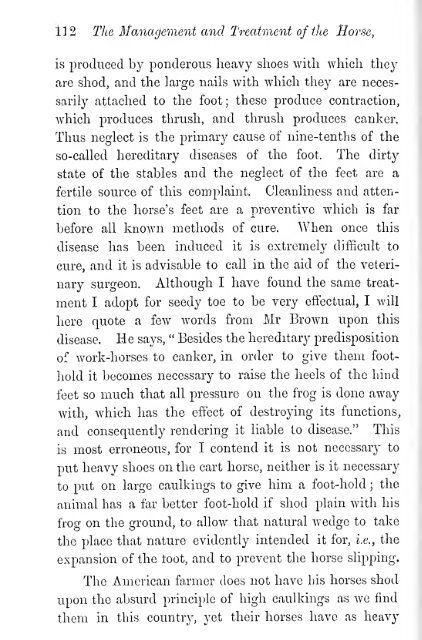The management and treatment of the horse in the stable, field, and ...
The management and treatment of the horse in the stable, field, and ...
The management and treatment of the horse in the stable, field, and ...
You also want an ePaper? Increase the reach of your titles
YUMPU automatically turns print PDFs into web optimized ePapers that Google loves.
112 <strong>The</strong> Management <strong>and</strong> Treatment <strong>of</strong> <strong>the</strong> Horse,<br />
is produced by ponderous heavy shoes with which <strong>the</strong>y<br />
are shod, <strong>and</strong> <strong>the</strong> large nails with which <strong>the</strong>y are neces-<br />
sarily attached to <strong>the</strong> foot; <strong>the</strong>se produce contraction,<br />
which produces thrush, <strong>and</strong> thrush produces canker.<br />
Thus neglect is <strong>the</strong> primary cause <strong>of</strong> n<strong>in</strong>e-tenths <strong>of</strong> <strong>the</strong><br />
so-called hereditary diseases <strong>of</strong> <strong>the</strong> foot. <strong>The</strong> dirty<br />
state <strong>of</strong> <strong>the</strong> <strong>stable</strong>s <strong>and</strong> <strong>the</strong> neglect <strong>of</strong> <strong>the</strong> feet are a<br />
fertile source <strong>of</strong> this compla<strong>in</strong>t. Cleanl<strong>in</strong>ess <strong>and</strong> atten-<br />
tion to <strong>the</strong> <strong>horse</strong>'s feet are a preventive which is far<br />
before all known methods <strong>of</strong> cure. When once this<br />
disease has been <strong>in</strong>duced it is extremely difficult to<br />
cure, <strong>and</strong> it is advisable to call <strong>in</strong> <strong>the</strong> aid <strong>of</strong> <strong>the</strong> veteri-<br />
nary surgeon. Although I have found <strong>the</strong> same treat-<br />
ment I adopt for seedy toe to be very effectual, I will<br />
here quote a few words from Mr Brown upon this<br />
disease. He says, " Besides <strong>the</strong> hereditary predisposition<br />
<strong>of</strong> work-<strong>horse</strong>s to canker, <strong>in</strong> order to give <strong>the</strong>m foot-<br />
hold it becomes necessary to raise <strong>the</strong> heels <strong>of</strong> <strong>the</strong> h<strong>in</strong>d<br />
feet so much that all pressure on <strong>the</strong> frog is done away<br />
with, which has <strong>the</strong> effect <strong>of</strong> destroy<strong>in</strong>g its functions,<br />
<strong>and</strong> consequently render<strong>in</strong>g it liable to disease." This<br />
is most erroneous, for I contend it is not necessary to<br />
put heavy shoes on <strong>the</strong> cart <strong>horse</strong>, nei<strong>the</strong>r is it necessary<br />
to put on large caulk <strong>in</strong>gs to give him a foot-hold ; <strong>the</strong><br />
animal has a far better foot-hold if shod pla<strong>in</strong> with his<br />
frog on <strong>the</strong> ground, to allow that natural wedge to take<br />
<strong>the</strong> place that nature evidently <strong>in</strong>tended it for, i.e., <strong>the</strong><br />
expansion <strong>of</strong> <strong>the</strong> toot, <strong>and</strong> to prevent <strong>the</strong> <strong>horse</strong> slipp<strong>in</strong>g.<br />
<strong>The</strong> American farmer does not have his <strong>horse</strong>s shod<br />
upon <strong>the</strong> absurd pr<strong>in</strong>ciple <strong>of</strong> high caulk<strong>in</strong>gs as we f<strong>in</strong>d<br />
<strong>the</strong>m <strong>in</strong> this country, yet <strong>the</strong>ir <strong>horse</strong>s have as heavy
















